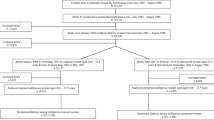Abstract
Reports of the human teratogenicity of retinoids have raised concern about the potential human teratogenicity of high doses of vitamin A. Nevertheless, there are few human case reports of excess intake of vitamin A during pregnancy and defective outcomes. No epidemiological studies have been carried out on this subject. Here we present the results of an epidemiological study of prenatal exposure to high doses of vitamin A in Spain, using data from the Spanish hospital-based, case-control registry. Although it is difficult to reach conclusions with such a very low exposure level (1.3 per 1,000 livebirths), our results suggest that a teratogenic effect might exist for exposures to high doses of vitamin A (OR = 0.5, p = 0.15 for less than 40,000 FU and OR = 2.7, p = 0.06 for 40,000 1U or more). As we might expect, this effect also seems to be related to the organogenetic status (OR = 5.4, p = 0.1 for 1st −2nd month, OR = 1.8, p = 0.4 for 3rd onwards) at the time of exposure.
Similar content being viewed by others
References
ArmitageP. (1955): Tests for linear trends in proportions and frequencies - Biometrics 11: 375–385.
BernhardtI.B and DorseyD. J. (1979): Hypervitaminosis A and congenital renal anomalies in a human infant - Obstet. Gynecol. 45: 7505.
BreslowN.E. and DayN.E. (1980): The analysis of case-control studies. Vol. 1 In Statistical Methods in Cancer Research. Lyon IARC. Scientific Publication. 32.
CochranW. G. (1954): Some methods of strengthening the common chi-square tests -Biometrics 10: 417–451.
CohlanS.Q. (1953): Excessive intake of Vitamin A as a cause of congenital anomalies in the rat - Science 117: 535.
GrayS. W. and SkandalakisJ.E. (1975): Embriology for surgeons - W.B. Saunders Ed. Pediatrica, Barcelona.
Hurley L.S. (1977): Nutritional Deficiencies and Excesses. In: Handbook of Teratology - Ed. J.G. Wilson and F.C. Fraser, Plenum Press 1: 269–282.
LammerE.J., ChenD.T., HoorR.M., et al. (1985 a): Retinoic acid embryopathy - N. Engl. J. Med. 313: 837–841.
LammerE.J., FlanneryD.B. and BarrM. (1985 b): Does isotretinoin cause limb reduction defects? -Lancet 8450 ii: 328.
LungarottiM.S., MarinelliD., MarianiT. and CalabroA. (1987): Multiple congenital anomalies associated with apparently normal maternal intake of vitamin A: A phenocopy of the isotretinoin syndrome? - Am. J. Med. Genet. 27: 245–248.
McBrideW.G. (1985): Limb reduction deformities in child exposed to isotretinoin in utero on gestation days 26–40 only - Lancet 1: 1276.
Martinez-FriasM.L., RodriguezA., SalgadoC., MartcillachM.L., SearaM.L. and GilM.T. (1978): El estudio de las malformaciones congénitas detectables durante los tres primeros dias de vita: epidemiología y prevención - Ed. por el SEREM, Madrid.
Martinez-FriasM.L., SalvadorJ., PrietoL. and ZaplanaJ. (1984): Epidemiological Study of Gastroschisis and Omphalocele in Spain - Teratology 29: 377–382.
Martinez-FriasM.L., SalvadorJ., AddnA. and FriasJ.L. (1986): Frecuencia de Defectos Congénitos en Espana: 1976–1983 - An Esp. Pediatr. 25; 3: 145–153.
Martinez-FriasM.L., FriasJ.L. and SalvadorJ. (1990): Clinical/Epidemiological analysis of Malformations -Am. J. Med. Genet. 35: 121–125.
MounoudR.L., KleinD., WeberF. (1975): A propos d'un cas de syndrome de Goldenhar: Intoxication aigue à la vitamine A chez la mere pendant grossesse- J. Genet. Hum. 23 (2): 135–154.
PilottiG. and ScortaA. (1965): Ipervitaminosi A gravidica e malformazioni neonatali dell'apparato urinario - Minerva Ginecol. 17: 1103–1108.
RosaF. W. (1983): Teratogenicity of isotretinoin -Lancet 2: 513.
RosaF. W., WilkA.L. and KelseyF.O. (1986): Teratogen Update: Vitamin A Congeners -Teratology 33: 355–364.
ShenefeltR.E. (1971): Morphogenesis of malformations in hamsters caused by retinoic acid: relation to dose and stage at treatment - Teratology 5: 103–118.
SmithellsR. W. (1983): Spina bifida and vitamins - Br. Med. J. 286: 388–389.
StangeL., CarlstomK. and ErikssonM. (1978): Hypervitaminosis in early human pregnancy and malformations of the central nervous systems - Act. Obstet. Gynecol. Scand. 57: 289–291.
Teratology Society Position Paper. Recommendations for vitamin A use during pregnancy - Teratology 35: 269–275.
Pallet H.L., Stark A.D., Costas K., Thompson S., Davis R. and Teresi N. (1985): Isotretinoin (Accutane), vitamin A, and human teratogenicity. Presentation American Public Health Association Meeting, Washington DC. November 20, 1985.
YonLennepE., El KhazenN., De PierreuxG. et al. (1985): A case of partial sirenomelia and possible vitamin A teratogenesis - Prenat. Diagn. 5 (1): 35–40.
Author information
Authors and Affiliations
Rights and permissions
About this article
Cite this article
Martínez-Frías, M.L., Salvador, J. Epidemiological aspects of prenatal exposure to high doses of vitamin a in Spain. Eur J Epidemiol 6, 118–123 (1990). https://doi.org/10.1007/BF00145783
Issue Date:
DOI: https://doi.org/10.1007/BF00145783




